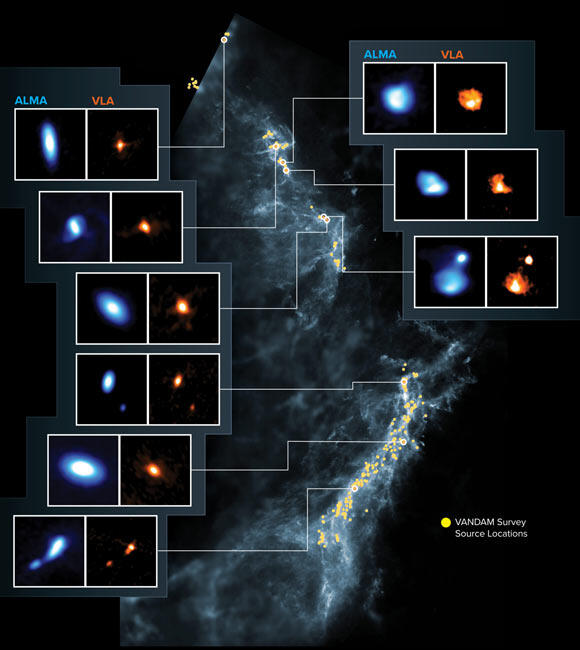Astronomers using NSF’s Karl G. Jansky Very Large Array and the Atacama Large Millimeter/submillimeter Array have detected 97 disks of gas and dust around young protostars in the constellation of Orion, which is home to the closest star-forming regions to Earth.
“Stars form from clouds of gas and dust that collapse under the force of their own gravity,” said lead author Dr. Patrick Sheehan, an astronomer at Northwestern University and the National Radio Astronomy Observatory, and his colleagues.
“Because of the initial angular momentum of the collapsing material, much of the material in the cloud forms into a disk rather than collapsing straight onto the star forming at the center.”
“Material is then accreted through the disk onto the star, which in turn regulates much of the final build up of stellar mass.”
“Moreover, it is in these protostellar disks that planets are expected to form, and so understanding their properties throughout their evolution is crucial for understanding how planets form.”
To understand this process better, the astronomers conducted a radio survey of young stars in the Orion Molecular Clouds, a giant star-forming region approximately 1,400 light-years from Earth in the constellation Orion.
They analyzed data collected by the Very Large Array (VLA) and the Atacama Large Millimeter/submillimeter Array (ALMA).
“Although the dust surrounding young stars blocks most visible light, it is more transparent to radio light,” the researchers noted.
“Because of this, the radio observations of the VLA and ALMA allowed us to have a detailed view of young star systems.”
The survey is known as the VLA/ALMA Nascent Disk and Multiplicity (VANDAM) survey, the largest survey of young stars ever made.
“With the VANDAM survey, we measured the size and mass of many young protoplanetary disks and compared them to older disks ALMA has already studied,” the scientists said.
“One of the things we found was that younger disks are generally more massive than older disks of the same size.”
“This makes sense since as a star forms it captures more nearby material, which reduces the mass of its surrounding disk.”
“But it also implies that the largest worlds of a planetary system start to form early on when the protoplanetary disk is more dense.”
Older protoplanetary disks typically have rings within them where there is significantly less material.
These gaps within the disk are often regions where planets are forming, but they could also indicate a resonant structure within the disk, where the gravitational tug of young planets causes gaps to form, similar to the way Jupiter creates orbital gaps in the asteroid belt.
The authors found similar gap structures within disks as young as 100,000 years, which is surprisingly early.
“Within the first million years of a system, the structure of a disk is similar to that of older disks,” they said.
“A few of the systems seen in the VANDAM survey were very irregular in shape.”
“It’s possible that these systems are so young that a disk system hasn’t begun to form.”
“It could also be the case that even the protostar hasn’t fully taken shape.”











